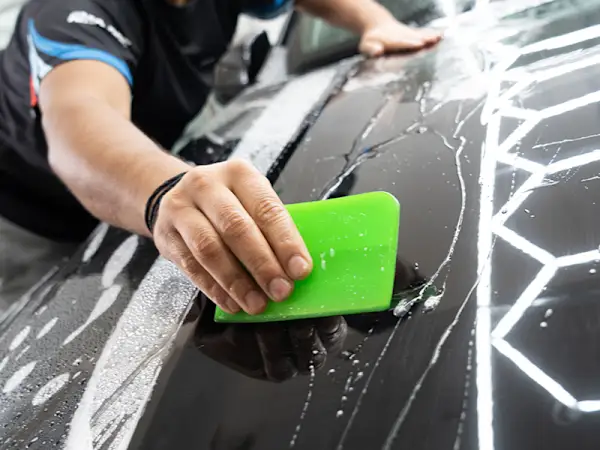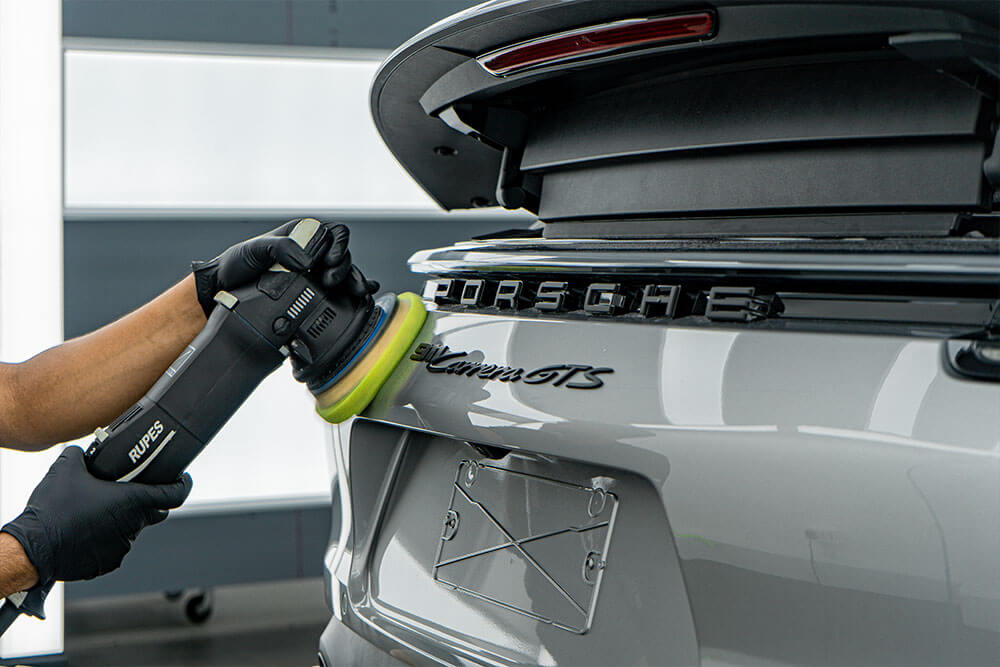
We saw it firsthand at the Dubai Autodrome during the 2025 racing season: a Porsche 992 GT3 spinning out and hitting the barriers at over 180 km/h during a practice session. Even in less dramatic incidents, like the Asian Le Mans series race earlier this year, cars were constantly pitting with front-end damage from unseen incidents, dropping debris all over the track. This is the reality of pushing a supercar to its limits.
The thrill of a track day is undeniable, but from our experience, a single session can inflict more damage on your paint than a year of road driving. The front of your car isn’t just dealing with sand; it’s being sandblasted by a high-velocity spray of molten tire rubber, pulverized asphalt, and corrosive brake dust from the car ahead. This isn’t a job for a standard car protection film.
You bought your performance car to drive it, not to worry about every lap. This guide is our insider’s take on how to properly prepare your PPF car for the track. We’ll cover what works, what doesn’t, and how the right paint protection film strategy can give you the freedom to drive hard with total peace of mind.
The Racetrack Gauntlet – A Different Level of Damage
The damage a car sustains on a racetrack is fundamentally different from daily driving. It’s more intense, more concentrated, and comes from sources you’d never encounter on Sheikh Zayed Road. From our experience working with track day enthusiasts at the Dubai Autodrome, we see a multi-front assault on a car’s paintwork.
First, there’s the high-velocity debris, and it’s far more than just dust. When you’re chasing another car down the main straight, their semi-slick tires are flinging what we call “clag” or “marbles”—sticky, molten chunks of rubber—at your front end. This is combined with a sandblasting of sharp gravel from the kerbs and bits of pulverized asphalt. The real wild card, however, is debris from other cars. We saw it during the 2025 Asian Le Mans series race right here in Dubai, where minor collisions left sharp carbon fiber shards and other parts on the track, leading to a safety car. Hitting even a small piece of that at speed can cause significant damage that a standard car protection film isn’t built to handle.
Second is the intensely corrosive brake dust. High-performance brake systems, especially carbon ceramics, generate fine metallic dust at extreme temperatures. This isn’t like normal road dust; it’s highly abrasive and can bake into your paint’s clear coat, causing permanent pitting and staining that can’t be washed off.
Finally, there are the other track-specific hazards. A car ahead might leak oil or coolant, splashing your paint with chemicals that can stain or etch the surface if not cleaned immediately. The track surface itself can be a threat, with older sections or aggressive kerbs dislodging chunks of pavement. These hazards require a robust paint protection film designed for the worst-case scenario. The most vulnerable impact zones on a PPF car during a track day are the front bumper, hood, and fenders, but also the rocker panels and the area behind the front wheels. As you corner hard, your own tires become an enemy, blasting the sides of your car with a constant stream of debris. Without specialized protection, a single track day can easily result in significant, costly damage.
Your First Line of Defence: The Sacrificial Shield
So, how do you defend against this level of punishment? Let’s be clear: your usual paint protection methods won’t cut it here. Relying on wax or even a high-end ceramic coating on a racetrack is like wearing a t-shirt to a paintball match. While a ceramic coating is fantastic for gloss and making your car easy to clean, it offers almost no real defense against the physical, high-impact assault of a track environment. It simply wasn’t designed to absorb the force of a stone chip at 200 km/h.
This is where a high-quality car protection film becomes essential. Think of it as a sacrificial shield—a thick, durable, and impact-absorbing layer of thermoplastic urethane that is physically applied over your paint. Its entire purpose is to take the hits so your factory paint doesn’t have to. When that piece of gravel or molten tire rubber strikes, the film disperses the energy, preventing a chip or deep scratch. This is the only technology that provides a true physical barrier against the unique dangers of the track.
The RMA “Track Pack” – Maximum Protection Where It Counts
Not all paint protection film applications are designed for the track. For our clients who are serious about performance driving, we recommend a specific coverage strategy we call the “Track Pack.” This isn’t about partial protection; it’s about strategically armoring the most vulnerable areas of your PPF car.
A proper Track Pack includes, at a minimum, full coverage of the highest-impact zones: the entire front bumper, the full hood, both front fenders, and the side mirrors. These are the areas that face the brunt of the debris kicked up by cars in front of you. But we also insist on covering the rocker panels along the sides of the car and the area just behind the front wheels. Why? Because when you’re cornering hard, your own front tires become one of your biggest enemies, blasting the side of your car with a constant stream of rubber and gravel.
For this application, we use a premium, thick paint protection film chosen specifically for its high impact resistance and self-healing properties. That self-healing top coat is your best friend on the track. When sticky tire rubber scuffs the surface, or light abrasions occur, the heat from the engine and the sun helps the film smooth itself out, keeping the finish looking clean and clear, lap after lap.
Drive Hard, Worry Less
A track day is the ultimate expression of automotive passion, but that passion shouldn’t come with a hefty repair bill for your car’s paint. As we’ve seen, the racetrack is a uniquely hostile environment, where high-velocity debris, corrosive brake dust, and molten tire rubber are guaranteed to attack your vehicle’s finish. Standard protection just isn’t enough to withstand this assault.
The only real solution is a robust, professionally installed paint protection film. By applying a strategic “Track Pack” that covers the full front end and other high-impact zones, you create a durable, sacrificial shield that absorbs the damage, keeping your factory paint pristine underneath.
Ultimately, the greatest benefit of a proper car protection film isn’t just a flawless finish; it’s freedom. It’s the freedom to push your car to its limits, to chase that perfect lap, and to enjoy every moment of the experience without the nagging fear of expensive paint damage. Protect your investment, and more importantly, protect your passion. Contact the enthusiasts at RMA PPF to get your car properly shielded before your next track day, and drive hard with total peace of mind.


